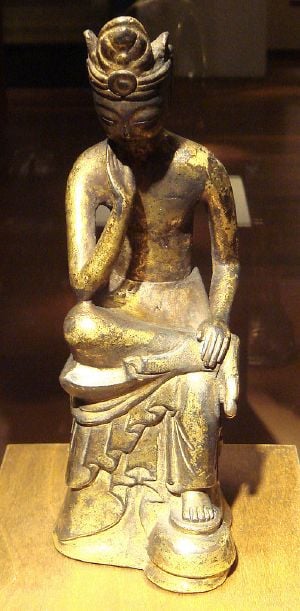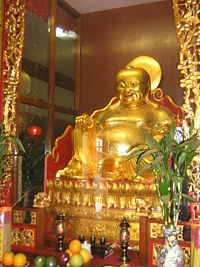Maitreya
| Names | |
|---|---|
| Sanskrit: | मैत्रेय (Maitreya) |
| Pāli: | मैत्तेय (Metteyya) |
| Chinese Name: | 彌勒菩薩 (Mílè Púsa) |
| Japanese Name: | 弥勒菩薩 (Miroku Bosatsu) |
| Vietnamese Name: | Di-lặc Bồ Tát |
| Tibetan Name: | byams pa |
| Korean Name: | 미륵보살 (Mirug Bosal) |
| Thai Name: | ศรีอรายะ เมตไตรย์ (Sriaraya Mettrai) |
Maitreya, the "future Buddha" in Buddhist eschatology, is a Bodhisattva that many Buddhists believe will eventually appear on earth, achieve complete enlightenment, and teach the pure dharma. As such, he will be the spiritual successor of the historic Śākyamuni Buddha. Unlike his antecedent, however, Maitreya is understood in a more millennial light, as he is predicted to be a “world-ruler,” uniting those over whom he has dominion. This aspect of his legend has been tremendously influential in the development of various apocalyptic and Utopian sects—and even armed rebellions—throughout Asian history.
The prophecy of the arrival of Maitreya is found in the canonical literature of all Buddhist sects (Theravāda, Mahāyāna and Vajrayāna) and is accepted by most Buddhists as a factual statement about a long-distant (or, in some cases, an incipient) millennial age.
Characterization: Maitreya as Future Buddha
As mentioned above, Maitreya represents the millennial aspirations of the vast majority of the world's Buddhists, regardless of their particular doctrinal orientations. In eschatological terms, it is thought that Maitreya’s coming will occur after the current Buddha's teachings (the Dharma) are completely forgotten and the world is left in a moral vacuum. At this time, the enlightened bodhisattva will descend from his miraculous abode in Tuṣita Heaven (literally, the realm of the "contented ones")[1] and be reincarnated as a human child. Once he attains adulthood, it is foretold that Maitreya will attain Bodhi (true enlightenment) in seven days, by virtue of his many lives of preparation for Buddha-hood (similar to those reported in the Jataka stories of Shakyamuni Buddha).
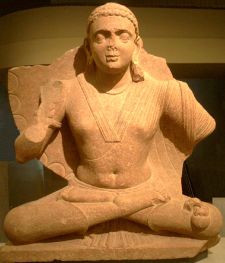
In addition to his role as a spiritual leader, Maitreya was also styled after the chakravartin monarchs of Indian history and mythology ("Dharma kings" such as Asoka). As such, it was thought that he would emerge as a benevolent ruler over humanity, ushering in an era of peace and prosperity. Existing accounts suggest that the era of the "Future Buddha" would be characterized by the end of death, warfare, famine, and disease, "the fulfillment of Buddha's law," and "the establishment of universal peace and concord."[2] This being said, it may be a false parallel to see Maitreya as an apocalyptic figure, as he may instead be interpreted as a figure of renewal. As Corless suggests, Maitreya can, in certain contexts, be seen as "the future Buddha in the sense that, the Dharma having decayed, he will come to restore it. He does not often, it appears, himself destroy the old in order to bring in the new."[3]
One of the earliest mentions of Maitreya can be found in the Sanskrit Maitreyavyākaraṇa (The Prophecy of Maitreya), which states that stating that gods, men and other beings will worship Maitreya and:
will lose their doubts, and the torrents of their cravings will be cut off: free from all misery they will manage to cross the ocean of becoming; and, as a result of Maitreya's teachings, they will lead a holy life. No longer will they regard anything as their own, they will have no possession, no gold or silver, no home, no relatives! But they will lead the holy life of chastity under Maitreya's guidance. They will have torn the net of the passions, they will manage to enter into trances, and theirs will be an abundance of joy and happiness, for they will lead a holy life under Maitreya's guidance.[4]
Origins and Etymology
The name Maitreya or Metteyya is derived from the word maitrī (Sanskrit) or mettā (Pāli) meaning "loving-kindness," which is in turn derived from the noun mitra (Pāli: mitta) ("friend").[5]
This linguistic correspondence has caused some theorists to speculate that the figure of Maitreya was influenced by the Zoroastrianism Mithra, a god of contracts, associated with the Sun. This perspective is clearly explicated by Tansen Sen, in his Buddhism, Diplomacy, and Trade: The Realignment of Sino-Indian Relations:
In fact, the original inspiration for Maitreya, the Buddha of the post-decline phase of the doctrine, may have been the Zoroastrian cult of savior (Saosyant) or the Persian-Greek Messiah Mithras Invictus, introduced into India by some of the same foreign groups blamed for the eventual destruction of Buddhism. Victor H. Mair has explained that the names Maitreya and Mithra … go back to the same Indo-European root. In Brahmanical tradition, Mitrah ("friend" / "companion") is a god of friendship, who is often invoked as an upholder of order, punisher of falsehood, supporter of heaven and earth, and bringer of rain. Similarly, in Buddhism, Maitreya (Pali Metteyya) means "the Benevolent (Friendly) One," a bodhisattva who is also the Buddha of the future. … Indeed, as Romila Thapar points out, the popularity of the Maitreya cult in the northern tradition of Buddhism may have derived from a complex historical situation that resulted in the "juxtapostion of a number of competing religions along the routes linking India, Iran, central Asia, and east Asia."[6]
Iconographic Representations
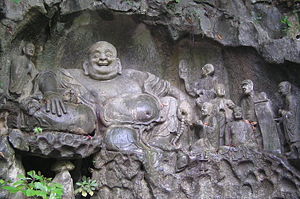
Many images of Maitreya portray him seated on a throne or in a meditative posture — both of which represent his future role in embodying the Dharma. In both cases, he is often depicted in the dress of either a renunciant monk or Indian nobleman, wearing a small stupa in his headdress, and (occasionally) holding a Dharma wheel and/or lotus. In many of these images, he is flanked by his two acolytes, Asanga and his brother, Vasubandhu.[7] In the Greco-Buddhist art of Gandhara, in the first centuries C.E. in northern India, Maitreya was the most popular figure to be represented, second only to the Buddha himself.
Over time, Maitreya also became conflated with the portly East Asian Budai (the obese "laughing Buddha" depicted to the right), a tenth-century monk who was thought to be his incarnation. In these icons, the Laughing Buddha is often ringed by children, who collectively represent his popular role as a provider of offspring.[8]
Maitreya Claimants
While a number of persons have proclaimed themselves to be Maitreya in the years following the Buddha’s death, none have been officially recognized by the sangha and the mass of lay Buddhists. A particular difficulty faced by any would-be claimant to Maitreya's title is the fact that the Buddha is considered to have made a number of fairly specific predictions regarding the circumstances that would occur prior to Maitreya's coming, including the notions that the teachings of the Buddha would be completely forgotten, and that all of the remaining relics of Sakyamuni Buddha have been gathered in Bodh Gaya and cremated.[9] In spite of these difficulties, many religious leaders have styled themselves as incarnations of Maitreya, using his name to form new Buddhist sects or to found new religious movements.
- Budai, the Chinese monk who lived during the Later Liang Dynasty (907–923 C.E.) mentioned above, is likely the most popular claimant to the mantle of Maitreya (despite his utter refusal involve himself in worldly politics). His depiction as the Laughing Buddha continues to be very popular in East Asian culture.
- Gung Ye (ruled 901–918), a Korean warlord and king of short-lived state of Taebong during the tenth century, claimed himself to be a living incarnation of Maitreya and ordered his subjects to worship him. His claim was widely rejected by most Buddhist monks and later he was dethroned and killed by his own servants.
- In 613 the monk Xiang Haiming claimed himself Maitreya and adopted an imperial title.[10]
- In 690 Empress Wu Zetian inaugurated the Second Zhou dynasty, proclaimed herself an incarnation of the future Buddha Maitreya, and made Luoyang the "holy capital." In 693 she replaced the compulsory Dao De Jing in the curriculum temporarily with her own Rules for Officials.[11]
- Lu Zhong Yi, the 17th patriarch of I-Kuan Tao, proclaimed himself to be an incarnation of Maitreya.
- L. Ron Hubbard (1911 – 1986), founder of Dianetics and Scientology, suggested he was "Metteya" (Maitreya) in the 1955 poem Hymn of Asia. His editors indicated, in the book's preface, specific physical characteristics said to be outlined—in unnamed Sanskrit sources—as properties of the coming Maitreya; properties which Hubbard's appearance reportedly aligned with.
- Raël, founder of the Raëlian church, claims to be Maitreya based on an idiosyncratic interpretation of the Agama Sutra (Japanese: Agon Sutra),[12] an ancient text said to be written by Buddha himself. Raël has claimed directly to people attending Asia Raëlian Church seminars, that someone born in France, a country which is often symbolized by the cock (or rooster), west of the Orient, meets the criteria of the Maitreya. Rael himself claims to be this individual.[13]
- Bahá'ís believe that Bahá'u'lláh is the fulfillment of the prophecy of appearance of Maitreya. Bahá'ís believe that the prophecy that Maitreya will usher in a new society of tolerance and love has been fulfilled by Bahá'u'lláh's teachings on world peace.[14]
Rebellious Maitreya Sects
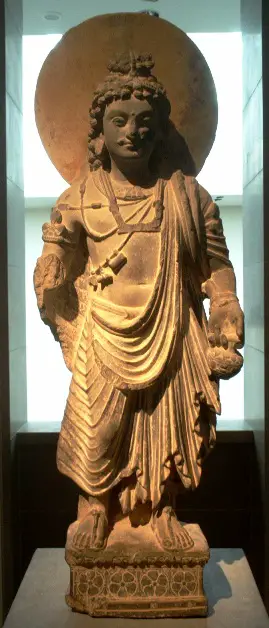
Given Maitreya's prophesied role in re-establishing the Dharma in the mortal world, it is unsurprising these accounts were tremendously influential in prompting uprisings against the perceived immorality of the present age. As Corless notes, "this 'messianic' expectation (as it has sometimes been called) has been an important part of the political history of Southeast Asia from time to time. For instance, the Burmese revolution against colonial domination was fueled in part by the identification of one or another revolutionary hero with Metteyya in the form of the righteous Buddhist king Satkya-Min (a Burminization of the Pali Chakkavatti, 'Wheel Turning Emperor')."[15] Such movements were a particularly prominent force in the history of China, as will be outlined below.
Pre-Maitreyan Buddhist Messianic Rebellions
Southern and Northern Dynasties
- 515
- The Mahayana Rebellion. In the late summer of that year, the renegade monk Faqing married a nun and formed a sect in the Northern Wei province of Jizhou (in the southern part of today’s Hebei province) with the assistance of a local aristocrat named Li Guibo. The sect was named the Mahayana ("The Great Vehicle," in reference to Mahayana Buddhism), and Li Guibo was given the titles of Tenth-stage Bodhisattva, Commander of the Demon-vanquishing Army, and King who Pacifies the Land of Han by Faqing.
- Using drugs to send its members into a killing frenzy, and promoting them to Tenth-Stage Bodhisattva as soon as they killed ten enemies, the Mahayana sect seized a prefecture and murdered all the government officials in it. Their slogan was “A new Buddha has entered the world; eradicate the demons of the former age,” and they would kill all monks and nuns in the monasteries that they captured, also burning all the sutras and icons. After defeating a government army and growing to a size of over 50,000, the rebel army was finally crushed by another government army of 100,000. Faqing, his wife, and tens of thousands of his followers were beheaded, and Li Guibo was also captured later and publicly executed in the capital city Luoyang.
- The Fozu Tongji (Comprehensive Records of the Buddha), a chronicle of Buddhist history written by the monk Zhipan in 1269, also contains an account of the Mahayana Rebellion, but with significant deviations from the original account, such as dating the rebellion to 528 rather than 515.
- 516
- The Moonlight Child Rebellion. Toward the end of that year, another sect was discovered by local authorities in Yanling (a county or prefecture of Jizhou). A man named Fa Quan and his associates were claiming that an eight-year-old child named Liu Jinghui was a Bodhisattva called the Moonlight Child (yueguang tongzi), and that he could transform into a snake or a pheasant. They were arrested and sentenced to death on suspicion of seditious intent, but Jinghui had his sentence commuted to banishment on account of his youth and ignorance.[16]
- 517
- Early in the spring of that year, surviving remnants of the Mahayana rebels regrouped and mounted a sudden attack on the capital of Yingzhou province, which lay just northwest of their original base in Bohai prefecture. They were repelled only after a pitched battle with an army of slaves and attendants led by Yuwen Yan, the son of the provincial governor, and nothing more is known of their fate.[16]
Although a "new Buddha" was mentioned, these rebellions are not considered "Maitreyan" by modern scholars.[16] However, they would be a later influence on the rebel religious leaders that made such claims. Therefore, it is important to mention these rebellions in this context.
Maitreyan rebellions
Sui Dynasty
- 610
- On the first day of the Lunar New Year, several tens of rebels dressed in white, burning incense and holding flowers proclaimed their leader as Maitreya Buddha and charged into the imperial palace through one of its gates, killing all the guards before they were themselves killed by troops led by an imperial prince. A massive investigation in the capital (Chang'an) implicated over a thousand families.[16]
- 613
- A “skilled magician” named Song Zixian claimed to be Maitreya in Tang county (northwest of Yingzhou), and supposedly could transform into the form of a Buddha and make his room emit a glow every night. He hung a mirror in a hall that could display an image of what a devotee would be reincarnated as – a snake, a beast or a human being. Nearly a thousand “from near and far” joined his sect every day, and he plotted to first hold a Buddhist vegetarian banquet (wuzhe fohui) and then make an attack on the emperor who was then touring Yingzhou. The plot was leaked out, and Song was arrested and executed with over a thousand families of his followers.[16]
- 613
- The monk Xiang Haiming claimed to be Maitreya in Fufeng prefecture (western Shaanxi) and led a rebellion. The elite of the Chang’an area hailed him as a holy man (dasheng) because they had auspicious dreams after following him, and his army swelled to several tens of thousands before he was defeated by government troops.[16]
Tang Dynasty
- 710
- Wang Huaigu declared, "The Shakyamuni Buddha has declined; a new Buddha is about to appear. The House of Li is ending, and the House of Liu is about to rise".
Song Dynasty
- 1047
- Army officer Wang Ze led a revolt of Buddhists expecting Maitreya; they took over the city of Beizhou in Hebei before they were crushed [17] The Song Dynasty government declared Maitreya Sects to be "heresies and unsanctioned religions." Tens of thousands of Maitreya Sect followers were killed.
Yuan and Ming Dynasty
- 1351
- The Red Turban Rebellion (a.k.a. The First White Lotus Rebellion). Han Shantong (韓山童), leader of the White Lotus Society, and Army Commander Liu Futong (劉福通) rebelled against the Mongol masters of the Yuan Dynasty. Shantong's anti-mongol slogan was "The empire is in utter chaos. Maitreya Buddha has incarnated, and the Manichaean King of Light has appeared in this world."[18]
- In 1355, Han Shantong's son, Han Lin'er (韓林兒), was proclaimed "Emperor of the Great [Latter] Song" (大宋, referring to the dead Song Dynasty) (1355-1368?) by Liu Futong. Liu Futong claimed Han Lin'er was a direct descendant of the Zhao royal family who ruled the Song Dynasty. After Liu Futong's death, Zhu Yuanzhang took up command of the Red Turban Rebellion and later assassinated Han Lin'er to become Emperor Hongwu of the Ming Dynasty.
- According to Beijing University, "白莲教的首领韩山童称“明王”(他的儿子韩林儿称“小明王”),都体现其教义宗旨。朱元璋不仅曾经信仰白莲教,而且承认自己是白莲教起义军的一支(他曾为小明王左副元帅)。朱元璋取得政权后,国号称“明”。
"The leader of White Lotus sect, Han Shantong called himself Ming Wang (明王 - "King of Ming"), while his son, Han Lin'er called himself Xiao Ming Wang (小明王 - "Small King of Ming"). These illustrated their attachment to their sect motto. Zhu Yuanzhang not only believed and adhere to the teaching of White lotus Sect, but also regard his army as one of the faction of White Lotus Rebel army (he was once the vice-marshal of 小明王). Probably as successor, after Zhu Yuanzhang obtained the power to rule China, he called his country "Ming"."
This means the Ming Dynasty was named after the White Lotus figures of the "Big and Little Bright Kings."
Notes
- ↑ Stephan Shuhmacher and Gert Woerner, The Encyclopedia of Eastern Philosophy and Religion: Buddhism, Hinduism, Taoism, Zen (Boston: Shambala, 1994, ISBN 0877739803), 388. Tuṣita (Heaven) was said to be reachable through meditation, and was notable for housing Śākyamuni Buddha prior to his human incarnation and his attainment of nirvana.
- ↑ Joseph M. Kitagawa, "The Many Faces of Maitreya: A Historian of Religions' Reflections" in Sponberg and Hardacre's Maitreya: The Future Buddha, 7-22. 10; David S. Noss, A History of the World's Religions, Eleventh Ed. (Upper Saddle River, NJ: Prentice Hall, 2003, ISBN 0130991651), 203; Roger J. Corless, The Vision of Buddhism (New York: Paragon House, 1989, ISBN 1557782008), 257-258.
- ↑ From Roger Corless' review of Sponberg and Hardacre's Maitreya: The Future Buddha, Journal of the American Oriental Society 110 (2) (April - June 1990): 386-387. 387.
- ↑ Trans. in Edward Conze, (ed.), Buddhist Scriptures (Baltimore: Penguin Books, 1959), 241.
- ↑ Shuhmacher and Woerner, 217.
- ↑ Tansen Sen, Buddhism, Diplomacy, and Trade: The Realignment of Sino-Indian Relations (Honolulu: University of Hawaii, 2003, ISBN 0824825934), 89-90.
- ↑ Noss, 203. For an extensive overview of the development and symbolism of Maitreyan iconography, see Inchang Kim's The Future Buddha Maitreya: An Iconological Study (New Delhi: D. K. Printworld, 1997, ISBN 8124600821).
- ↑ Shuhmacher and Woerner, 189, 282-283; Corless, 257.
- ↑ See Corless, 255-258, for an overview of these prophecies and movements.
- ↑ Hubert Seiwert, Popular Religious Movements and Heterodox Sects in Chinese History (Brill, 2003, ISBN 978-9004131460).
- ↑ Tang Dynasty Empire 618-906, Chapter published in Sanderson Beck. Retrieved November 18, 2019.
- ↑ Ian Reader, Religion in Contemporary Japan (University of Hawaii Press, 1991), 221.
- ↑ Rael, The Maitreya - Extracts From His Teachings (Raelian Foundation, 2004, ISBN 978-2940252176).
- ↑ Moojan Momen, Buddhism and the Bahá'í Faith Bahá'í Library, 1995. Retrieved November 18, 2019.
- ↑ Corless, 256.
- ↑ 16.0 16.1 16.2 16.3 16.4 16.5 Shao-yun Yang, Making Sense of Messianism: Buddhist Political Ideology in the Mahayana Rebellion and the Moonlight Child Incident of Early Sixth-Century China Retrieved November 18, 2019.
- ↑ Sanderson Beck, Song Dynasty Renaissance 960-1279, China, Korea & Japan to 1875 (World Peace Communications, 2005, ISBN 0976221012). Retrieved November 18, 2019.
- ↑ Jonathan N. Lipman and Stevan Harrell (eds.) Violence in China: Essays in Culture and Counterculture (SUNY Press, 1990, ISBN 978-0791401132).
ReferencesISBN links support NWE through referral fees
- Beck, Sanderson. China, Korea & Japan to 1875. World Peace Communications, 2005. ISBN 0976221012.
- Conze, Edward (ed.). Buddhist Scriptures. Baltimore: Penguin Books, 1959.
- Corless, Roger J. The Vision of Buddhism. St Paul, MN: Paragon House, 1989. ISBN 1557782008.
- Humphreys, Christmas. A Popular Dictionary of Buddhism, Second Ed. Lanham, MD: Rowman and Littlefield, 1976. ISBN 087471737X.
- Kim, Inchang. The Future Buddha Maitreya: An Iconological Study. New Delhi: D. K. Printworld, 1997. ISBN 8124600821.
- Lipman, Jonathan N., and Stevan Harrell (eds.). Violence in China: Essays in Culture and Counterculture. SUNY Press, 1990. ISBN 978-0791401132
- Noss, David S. A History of the World's Religions, Eleventh Ed. Upper Saddle River, NJ: Prentice Hall, 2003. ISBN 0130991651.
- Nyanatiloka. Buddhist Dictionary: Manual of Buddhist Terms and Doctrines. San Francisco: Chinese Materials Center, 1977.
- Rael. The Maitreya - Extracts From His Teachings. Raelian Foundation, 2004. ISBN 978-2940252176
- Reader, Ian. Religion in Contemporary Japan. Honolulu: University of Hawaii Press, 1991. ISBN 0824813545.
- The Seeker's Glossary of Buddhism. Taiwan: The Corporate Body of the Buddha Educational Foundation, 1998.
- Seiwert, Hubert. Popular Religious Movements and Heterodox Sects in Chinese History. Brill, 2003. ISBN 978-9004131460
- Sen, Tansen. Buddhism, Diplomacy, and Trade: The Realignment of Sino-Indian Relations. Honolulu: University of Hawaii, 2003. ISBN 0824825934.
- Shuhmacher, Stephan, and Gert Woerner. The Encyclopedia of Eastern Philosophy and Religion: Buddhism, Hinduism, Taoism, Zen. Boston: Shambala, 1994. ISBN 0877739803.
- Sponberg, A. and H. Hardacre (eds.). Maitreya, the Future Buddha. Cambridge University Press, 1988. ISBN 0521343445.
External links
All links retrieved March 27, 2025.
- Mission of Maitreya, Eternal Divine Path
- The Bodhisattva Ideal - Buddhism and the Aesthetics of Selflessness.
- A Contemplation on Maitreya - The Coming Buddha
- Who is Maitreya?
Credits
New World Encyclopedia writers and editors rewrote and completed the Wikipedia article in accordance with New World Encyclopedia standards. This article abides by terms of the Creative Commons CC-by-sa 3.0 License (CC-by-sa), which may be used and disseminated with proper attribution. Credit is due under the terms of this license that can reference both the New World Encyclopedia contributors and the selfless volunteer contributors of the Wikimedia Foundation. To cite this article click here for a list of acceptable citing formats.The history of earlier contributions by wikipedians is accessible to researchers here:
The history of this article since it was imported to New World Encyclopedia:
Note: Some restrictions may apply to use of individual images which are separately licensed.
